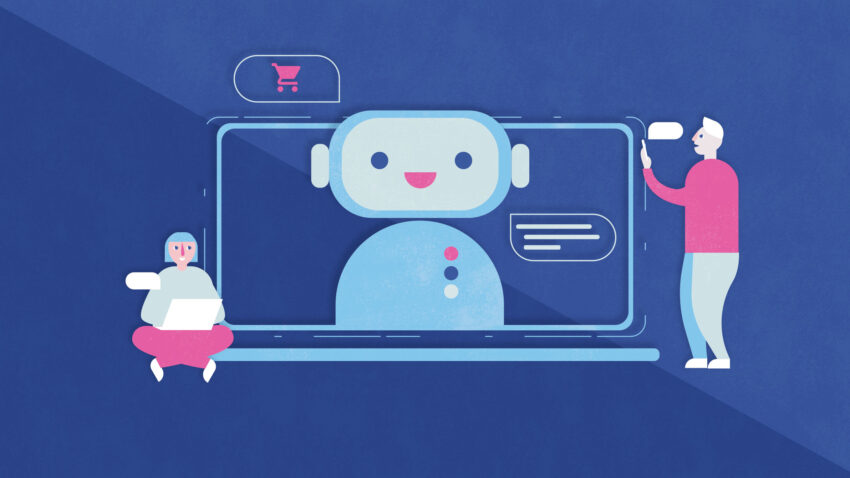Everyone who’s shopped online recently has experienced the chatbot pop-up: much like an in-store salesperson, the chatbot opens with a friendly “What can I help you with?” Many customers ignore it and keep browsing, others answer the question – sometimes they even receive the right answer. The similarities between a really great salesperson and a great chatbot come down to knowledge and demeanour. Until recently, the salesperson blew the chatbot out of the water on both counts.
Today the chatbot is not only catching up but rubbing virtual shoulders with sales and service agents to drive customer interaction, sales and satisfaction. In a COVID world shifting away from in-store experiences, new conversational AI technologies such as chatbots and voice assistants can be anywhere at any time, programmed to engage in more natural conversation, and capable of quickly connecting customers to the right service or sales people before they even contemplate dropping out of the chat.
Montreal-based AI company Heyday puts conversational AI into action in the rapidly changing retail sphere, where the customer journey has taken more than a few twists and turns lately. Heyday co-founder and CEO Steve Desjarlais recently outlined how the COVID pandemic has disrupted shopping habits, yet it hasn’t changed what customers want in a retail experience, whether it’s online or in-store: they want to have their questions answered, get the products or services they actually want, and along the way be treated as an individual.
“Shopping online isn’t just about convenience anymore. It’s evolved into something much bigger,” writes Desjarlais. In this case, something bigger really can be better, with more personalization throughout the customer journey, from customized search results to chatbots with the right answers and the ability to know when to transfer a customer to a human agent. The new normal has seen some brands rocket their digital strategies, cramming 10 years of evolution into a few months. It’s serendipitous that a boom in AI technology is happening at the same time, allowing companies who integrate AI tools into their CX to rapidly adapt to trends and grow.
Changing channels and the conversation
As a conversational AI platform, Heyday lets people communicate with websites, apps and devices simply by writing or talking as they naturally would. The difference with Heyday is its focus on not only recognizing human language and automating common interactions with ease, but definitively understanding what customers want, wherever they are in the CX journey.
“Heyday’s AI layer is on the front end of a brand’s website, there to discern the customer’s intent,” says Brad Wing, VP Strategy and Partnerships at Heyday. “That’s a really important position because 50-70% of questions can be the same, whether they sell bolts or watches or energy drinks: where’s my order, what’s going on with my refund, is the store open.”
The chatbot can meet customers where they are or where they prefer to be, physically or digitally, and can help serve them what they want or need based on past experiences, comparative audiences or the mining of deep data.
“Looking at common customer chat data, that boils down to about 150 individual questions, each of them having thousands of variations in multiple languages. A Heyday chatbot is able to handle up to 80% of FAQs coming in for customer service, and the remaining 20%, we escalate to the right team,” says Wing. “The chatbot can meet customers where they are or where they prefer to be, physically or digitally, and can help serve them what they want or need based on past experiences, comparative audiences or the mining of deep data. In terms of CX, that means customers can decide how they want to talk to the brand – whether over messaging, email, SMS on their phone, it’s up to them.”
For brands who want to more personally engage with customers, Heyday’s ecommerce and CRM integrations with Shopify, Lightspeed, Magento and Salesforce make it an attractive solution for both engagement at scale and monetization of customer service. The added bonus of Heyday’s AI layer is data captured from chats that can be brought into a company’s data strategy for understanding customer behaviour, boosting sales and maintaining meaningful customer relationships.
Coming from heavyweights in ecommerce (Lightspeed) and the video game industry (Ubisoft), the founders of Montreal-based AI company Heyday decided to build a better chatbot: they combined the sticky experience of a best-selling game with the latest in personalized CX. Heyday’s early pivot from the banking sphere to retail tapped into forward-thinking technological and consumer trends, solidifying the company’s vision for elevated, customized CX at scale.
“On the technology side, we saw more APIs become available and companies like Google released AI libraries that could be built on by other companies. At the same time, we saw a rise in consumers moving their conversations to communications tools like Facebook Messenger, WhatsApp, WeChat and other messaging channels,” says Wing.
“Heyday is the bridge between the ecommerce technology and the customer’s voice,” he explains. The channel from Heyday’s perspective could be Facebook Messenger, WhatsApp, Apple Business Chat, Google’s Business Messages or any text conversation channel that connects a company with its customers, helping brands have a conversation with their customers in the way that their customers want to communicate, rather than directing them into a phone call or an email.
AI for the people: How to improve customer experience with chatbots
Available as a self-serve app from the Shopify marketplace, the “mini version” of Heyday takes just 60 seconds to set up. Suddenly an artisan can have an AI chatbot on their storefront. What was almost unimaginable a year ago – a generic consumer-level AI chat tool – is now being used by hundreds of small businesses across the globe.
Recently, Heyday has leapt headfirst into democratization of its AI platform. While many companies want to take advantage of the platform’s power for customization and CRM integration, small companies and solo entrepreneurs now have access to Heyday through Shopify. Available as a self-serve app from the Shopify marketplace, the “mini version” of Heyday takes just 60 seconds to set up. Suddenly an artisan can have an AI chatbot on their storefront. What was almost unimaginable a year ago – a generic consumer-level AI chat tool – is now being used by hundreds of small businesses across the globe.
Meanwhile, the decidedly bespoke side of Heyday is giving medium to large companies like sporting goods retailer Decathlon and Make Up For Ever more flexibility in CX. These brands can integrate the AI chat technology to engage with customers across the channels they use most, from Facebook Messenger to Google Maps messages to WhatsApp.
“Our conversational platform sits in the middle of all this, collecting the information from those channels,” says Christine Dupuis, VP Product and Growth at Heyday. “The AI recognizes patterns and intents across each channel. For instance, users from certain demographics prefer Facebook, while Google Maps and Search inquiries are more often about store location or hours. Whatever they are about, whatever customers need, wherever they are, a brand can be there and be ready to answer.” With its attention to accurate automation, the AI conversational platform can answer up to 80% of support questions and direct the remaining 20% to a human agent.
“Because we have AI, we can provide open text Q&A for customers, letting people write whatever they want in the chat box,” says Dupuis. “Through a customer’s own words, we can see what their issue is, what they’re looking for and follow their journey. Brands don’t have to watch customers go down a predetermined path and wonder why they don’t want to follow it and drop out. We know that the customer journey is not as linear as it once was, so leaving it open – saying ‘You be you’ to customers and assuring them that the chatbot will figure out what they need – gives brands the opportunity to capture truly useful data that can be used to create a better customer journey.”
From conversation to increased sales
The line between customer service and sales blurs when an AI chatbot enters the CX space. Usually the employees managing a brand’s website and chat are support personnel rather than an expert in products or services. Conversational AI can be both. “Heyday’s platform makes that expertise available through a chat. It’s not meant to feel like a ticketing system of support, it’s meant to feel like talking to a person in the store,” says Dupuis.
Today every connection, every touchpoint is so important that you can’t let your customer service person only handle customer service problems.
High-growth ecommerce companies are harnessing this advantage and seeing close to a 50-50 split between customer service questions and sales questions in their customer-focused chat platforms. “Today every connection, every touchpoint is so important that you can’t let your customer service person only handle customer service problems,” remarks Wing. “For retail especially, it’s becoming a hybrid touchpoint: the agent can talk about sending a shipping label with a customer but also delve into why they need to return an item, for instance. Find the answer to that, you can save a sale.”
With a brand’s catalogue integrated into the backend of the AI platform and a conversational design team crafting a chat experience that feels authentic and engaging, more customers than ever are also using the chatbot as a search tool to find the products they want – and more beyond that.
“Though the way people shop has changed, especially with COVID, we’re still focusing on creating a pleasant, natural, positive experience,” says Dupuis. “Some of our retail clients now offer appointments to customers who prefer to shop in-store, so Heyday is adding appointment scheduling to the chat. In response to increased demand in the luxury market and from other big-ticket brands, we’ve started to add video calls to the chat, letting sales people and stylists easily show items to their customers before buying. In the future, as brands continue their journey to hyper-personalized experiences, our platform will increase its ability to push personalized product recommendations based both on the users intent and increasingly their context and history.”
One of Heyday’s newest features is also one of AI technology’s strengths when it comes to deriving actionable insights from massive amounts of data: the chatbot can detect sentiment in customers’ written text. “Most retailers see the advantage of still having a conversation, of having empathy with a customer in that space,” says Wing. “An AI conversation platform gives brands another avenue to get that message across and say ‘we hear you, we’re going to make every effort to listen to you and give you options you need’.”
“In a website chat box, we’re reproducing the experience that customers would have if they went into a store and spoke with somebody there,” says Dupuis, clarifying that though chat can’t be a complete duplicate of the in-person experience, of course, Heyday’s chat solution gets customers the answers they actually need, then and there, wherever in the digital world customers may be.
– written with files from Keatext contributor Robyn Fadden


